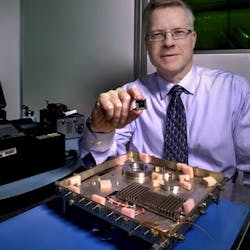NASA to build integrated photonics modem for International Space Station
An integrated photonics modem designed and built by researchers at the NASA Goddard Space Flight Center (Greenbelt, MD) will be tested aboard the International Space Station beginning in 2020 as part of NASA's multi-year Laser Communications Relay Demonstration (LCRD).
Once aboard the space station, the so-called integrated LCRD low-earth-orbit (LEO) user modem and amplifier (ILLUMA) will serve as an LEO terminal for NASA's LCRD, boosting the high-speed laser-based communications system's capabilities.
Since its inception in 1958, NASA has relied exclusively on radio frequency (RF)-based communications. Today, with missions demanding higher data rates than ever before, the need for LCRD has become more critical, says Don Cornwell, director of NASA's Advanced Communication and Navigation Division within the space Communications and Navigation Program, which is funding the modem's development.
Enabling video tracking of planetary conditions
LCRD will encode and transmit data at rates 10 to 100 times faster than today's communications equipment, requiring significantly less mass and power. LCRD-types technology could enable delivery of video and high-resolution measurements from spacecraft at other planetary bodies in the solar system, allowing researchers to track planetary conditions there in a similar way to how hurricanes and other climate and environmental changes are tracked on Earth.
The project, which is expected to begin operations in 2019, isn't NASA’s first foray into laser communications. A payload aboard the Lunar Atmosphere and Dust Environment Explorer (LADEE) demonstrated download and upload speeds to and from lunar orbit at 622 and 20 Mbit/s, respectively, in 2013.
LCRD, however, is designed to be an operational system after an initial two-year demonstration period. It involves a hosted payload and two ground stations. The mission will dedicate the first two years to demonstrating a fully operational system from geosynchronous orbit to ground stations. Once NASA demonstrates that capability, it plans to use ILLUMA to test communications between geosynchronous and LEO spacecraft, Cornwell says.

John Wallace | Senior Technical Editor (1998-2022)
John Wallace was with Laser Focus World for nearly 25 years, retiring in late June 2022. He obtained a bachelor's degree in mechanical engineering and physics at Rutgers University and a master's in optical engineering at the University of Rochester. Before becoming an editor, John worked as an engineer at RCA, Exxon, Eastman Kodak, and GCA Corporation.
